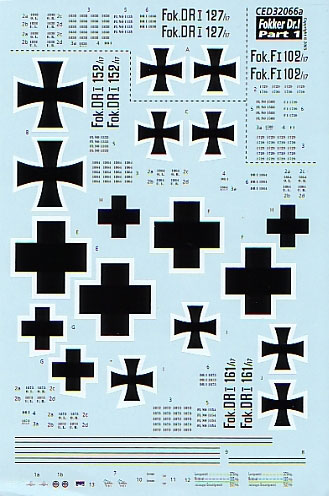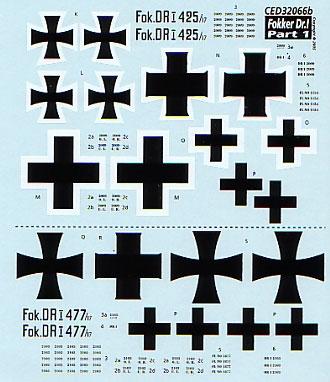|
S u m m a r y
|
| Catalogue
Number: |
CED32006 - The
Baron’s Tripes Fokker Dr.I Part 1 |
| Scale: |
1/32 |
| Contents and Media: |
Double-sided full colour
letter-sized instructions plus notes sheet; 1 x full-size and one
smaller decal
sheet. |
| Price: |
USD$9.99 from
Meteor Productions website |
| Review Type: |
FirstLook |
| Advantages: |
Superb research, very sharp
printing, excellent register, variety of MvR’s aircraft. |
| Disadvantages: |
|
| Recommendation: |
Highly Recommended |
Reviewed by Rob Baumgartner

HyperScale is proudly sponsored by Meteor
Productions
Ever wanted to build one of Manfred von Richthofen’s triplanes in 1/32nd
scale?
 There
is no excuse now with Cutting Edge having released this latest
extravaganza that caters for six of the Baron’s machines. There
is no excuse now with Cutting Edge having released this latest
extravaganza that caters for six of the Baron’s machines.
What makes these decals unique is that for the first time, the builder
is exposed to full and correct stencil data. One area that cried out for
correction in other sheets was the weights table. Now we have the
correct wording for this highly visible item.
The multiple application of the works number is an often forgotten
detail. This sheet covers these areas and items are provided for the
forward fuselage, tailplane, elevators, rudder, ailerons, struts and
wings. The struts have the additional position indicators as well and
these are seen with the abbreviated location indicators “U L”, “U R’, “O
L” and “O R”.
The “D R I” prefix for the wing works number makes a welcome appearance,
as does the “Fl” prefix used before the wing “set” number. As with all
stenciling, enough items are found for all locations for each triplane
represented.
One surprise was that a decal is even supplied for the upper wing
celluloid window, which displayed the works number and date of spar
manufacture.
An indication of completeness can be found with the inclusion of Fokker
logos, aircraft nameplate, and even stenciling for the inner wheel
covers. These and both the Axial’s logo and stamped markings show what a
comprehensive package this release is.
Naturally not all the items will be visible due to over painting with
Unit and personal markings. In many cases these could still be seen as
the covering qualities of a lot of the finishes left a lot to be
desired.
This is not just a collection of stencil data of course and the two
supplied sheets also include the various styles of national insignia
seen on the subject triplanes.
Some of the types discussed had markings that evolved over time and
these have not escaped the instructions. So in total, nine different
schemes result.
The Baron’s aircraft have been the subject of debate for many decades
but the interpretations offered here are logical and well thought out.
1. Fokker F.I, 102/17
This pre production aircraft was only at the front for a little over two
weeks but MvR still managed to score a couple of victories in it. These
were his 60th and 61st triumphs.
If you can’t wait for the release of the Roden F.I kit, their Dr.I can
be used but it will need some modification. Most of the necessary parts
are included but an alternative conversion kit is available from Cutting
Edge Modelworks.
2. Fokker Dr.I, 127/17
MvR chalked up three more successes in this early production triplane.
Two schemes are depicted in the instructions. One being in typical Fokker
streaked finish and the other having the Baron’s red Jasta and personal
markings applied to it.
3. Fokker Dr.I, 152/17
This is one of the more well known machines that the Baron flew. It
survived the war and was preserved in the Berlin Zeughaus Museum but was
sadly destroyed during the second great conflict. MvR gained his 64th,
65th and 66th victories in this machine.
Again there are two different schemes available to the modeler.
The first has the red cowl, wheels, struts, top wing and decking behind
the pilot as well as the whole rear tail area. The second option sees
the machine painted all over red with the modified over-thick crosses.
4. Fokker Dr.I, 161/17
Not a famous triplane by any means and can be considered one of MvR’s
reserve aircraft. He scored no victories in it and its finish was
similar to 152/17’s early scheme.
5. Fokker Dr.I, 425/17
The most famous of MvR’s triplanes, 425/17 was the machine in which he
scored his last two victories and ultimately met his death in the next
day. This aircraft went through many changes regarding the national
insignia and two are provided for on the decal sheet. Both tripes are
featured in their all red livery with the difference being in the style
of crosses worn at the different times.
6. Fokker Dr.I, 477/17
This is the triplane that MvR scored more victories in than any of the
others he flew; nine out of a total of nineteen in this type of
aircraft. It was unusual in its markings as the red was described as
being on the top of the tailplane only, the rest on the machine being in
typical Jasta 11 décor.
From the one available photograph, it appears that the lower wing
crosses differ from each other due to a state of transition. The sheet
supplies the two types concerned.

All of the images were extremely well printed with everything being
clear and legible. The carrier film is thin yet strong and “disappears”
when applied in the appropriate manner.
A more comprehensive decal sheet on the subject will not be found
anywhere.
The research by Mike Lampros is first class and provides the modeler
with a level of detail that should satisfy even the most fastidious
enthusiast.
With a complete set of stencil data and the large number of subjects
presented, what more could you want…
Highly recommended.
Thanks to Meteor Productions for the sample
Review Text Copyright © 2005 by
Robert Baumgartner
Page Created 29 September, 2005
Last updated
28 September, 2005
Back to
HyperScale Main Page |
Home | What's
New | Features
| Gallery |
Reviews | Reference
| Forum
| Search